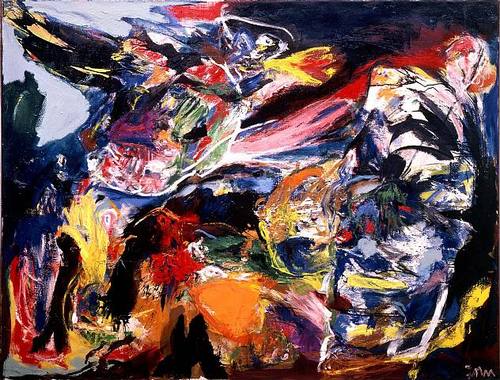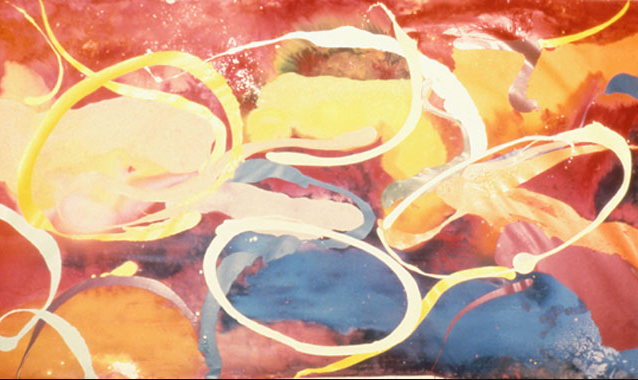This week, I’ve been feeling very artsy fartsy. It’s all this talk about color and my favorite artists. I blame the Daily Post. I’ve been listening to classical music for the last three days. I was talking with Male yesterday about the most beautiful music ever written. I said it’s Beethoven’s 9th symphony. He said, there’s no question that Beethoven’s 9th is the best piece ever written, but it’s not the most beautiful. This surprised me since, to me, they are the same thing.
What’s the difference between the best and the prettiest? I tried to separate them out, but couldn’t. I have music -> visual synesthesia, which means I see music as color, pattern and movement. Perhaps it’s my synesthesia that won’t allow me to see things as “technically great, but not beautiful” since I like what I like based on how visually beautiful it is. Visual takes precedence over auditory, but it goes both ways. When I look at art, I hear the music. I can look at a painting and see the music inside of it.
After Male’s ponderous supposition, I naturally asked him what is the most beautiful then? He didn’t really have an answer. I didn’t really have an answer either, so I decided to investigate it… with science! Actually, pseudo-science since I’m not a scientist. Whatever. Science shall be had, dammit.
This list only contains classical music since that is the prettiest music. There are some songs that are just beautiful that aren’t classical, but they can’t really compare to what’s on this list. Not only is it all classical, but it’s all for a full orchestra. I’m not all that fond of smaller pieces because they don’t have as much detail and therefore aren’t generally as colorful or visually interesting. So, after three days of clinical study of classical music, here is my list of the most beautiful orchestral pieces ever written from a synesthete’s perspective along with a representative work of art. The art isn’t exactly what I see since I didn’t create it, but it might give you a hint.
1. Beethoven.
Sorry, Male, but Beethoven’s 9th Symphony is still number one. Best and prettiest are synonymous in my brain. All of Beethoven is just stunning. If you’re going to listen to the 9th, you should really listen to the whole thing in order. It’s the only proper way, but here’s just a bit of it sung by 10,000 Japanese people.
What It Looks Like:
If you flipped this upside-down, it’d be closer. The darker colors are usually on the bottom.

2. Tchaikovsky.
After Beethoven, Tchaikovsky is my favorite composer. He’s sometimes darker than Beethoven and just as complicated. I think Tchaikovsky has the most beautiful oeuvre of any composer. Picking just one example of Tchaikovsky is impossible. I can barely even listen to The 1812 Overture since it turns me into putty by the end, so here’s March Slave (that’s march as in a style of music and slave as in Slavic–it has nothing to do with slavery). I’m generally not a huge fan of the flute, but Tchaikovsky is the only composer who can make the flute give me goosebumps (starting at around 1:45).
What It Looks Like:
Sort of like this, only a lot more colorful with less orange.

3. Mussorgsky.
It’s tough to choose between Pictures At An Exhibition and Night On Bald Mountain, but this one gives me goosebumps every damn time I hear it and nearly makes me cry. The whole piece is gorgeous, but it’s the last movement that takes me over the edge and makes it so I can hardly breathe. It’s the percussion: the chimes, gong, cymbals, et al. It is literally breathtakingly beautiful.
What It Looks Like:
Nothing can really capture how magnificent this piece of music is, but this Max Ernst painting kind of captures the energy and movement.

4. Holst
Ah, the planets. I’ve talked many time before about this piece. I think it’s one of the greatest ever written. I love the whole thing, but Jupiter is one of my favorites because it’s so heavy on the French Horn, my favorite instrument. The melodies that start at 1:45 and 3:04 are some of my favorite in all of music. Simply beautiful.
What It Looks Like:
It’s impossible to capture the whole piece, but this one reminds me a little bit of it with its starry background. It needs a whole lot more purple though to be accurate.

5. Barber
Adagio For Strings. Enough said. It’s one of the most beautiful pieces ever written. Visually, it doesn’t look as sad as it sounds. It’s more like birds flying at sunrise.
What It Looks Like:
I’m having a hell of a hard time finding an image for this one. Nothing can really match Adagio For Strings. This one has similar tone, curves and color palette, but it’s got too many sharp angles and straight lines. There are no straight lines in Adagio For Strings. The movement actually looks much like the conductor’s hands making lazy circles or like a ribbon slowly woven through three dimensional space.

6. Prokofiev.
I love Prokofiev. I grew up with a battered and much-listened vinyl version of Peter And The Wolf. It’s still one of my favorites. Prokofiev knew each instrument intimately and had such a way with combining and using instruments, singling them out and putting them right back in the mix, like he did in Peter and The Wolf. Symphony #1 is a conversation between instruments in a hive. The violin starts a sentence, the woodwinds take up the middle and the brass finishes it. This is not my favorite Prokofiev, but hopefully, it will give you an idea what I’m talking about.
What It Looks Like:
Prokofiev is more structured and colorful, and less muddled than this Pollack, but the circular, almost woven quality about it, and the sunny tone of this painting sum it up nicely.

7. Rimsky-Korsakov.
Are you sensing a pattern here? It seems I love the Russians. Fair enough. They make great music. Rimsky-Korsakov loved using the lower end of the register, which is why I love Rimsky-Korsakov, but he also knew how to balance it just perfectly. Sheherazade starts out with a bang and then the whole thing hangs off of one single violin. It’s dark, but it’s also uplifting and hauntingly beautiful. It’s like a forest.
What it looks like:
If this were shaped more like a triangle with the beautiful violin part at the top holding it up, it would be closer. The colors are right though. A sea of midnight blue with explosions of color.

8. Dvorák
A Czech! Dvorák, like the Russians, loved big sound. He used big, bold brushstrokes accented by finer ones. His music waxes and wanes like the moon pulling the oceans.
What It Looks Like:
Dvorák is more complicated than this painting, but the ferris wheel-esque thing in the lower left is very close and the black is the tympani. If you took this painting and made it more complicated and less red, that’s Dvorák.

9. Puccini
It doesn’t matter which Puccini opera you listen to: La Boheme, Madama Butterfly, Gianni Schicchi, Turandot, Tosca. They all have at least one amazing song. Opera doesn’t get any better than Puccini. I highly recommend Nessun Dorma from Turandot, O Soave Fanciulla from La Boheme, Vogliatemi Bene, Un Bene Piccolino and Un Bel Di Vedremo from Madame Butterfly, and of course, this one:
Specifically, I love Maria Callas singing it. Her voice is technically not the most beautiful of all opera singers, but she did something better than anyone: emote. Her heart came out through her mouth every time she opened it and it’s beautiful.
What Maria Callas’ heart looks like:

10. Mozart
Lacrimosa (lachrymose) is Latin for “weeping” and this certainly does make me want to cry, but not necessarily because it’s sad. While it is a little mournful, it makes me want to weep because it is exquisitely beautiful.
What It Looks Like:
This is too geometrical, but the colors and tone are right.

Honorable Mentions
- Shostakovitch Symphony # whichever. They’re all good. Here’s, oh… #5.
- Vivaldi -Four Seasons, particularly Winter
- Verdi – Trovatore Anvil Chorus
- Delibes – Lakmé: Flower Duet
- Orff – Carmina Burana: O Fortuna
- Bach – Air On The G String
- Copland – Fanfare For The Common Man
- Handel- Arrival Of The Queen Of Sheba and Minuet II
- Grieg – Peer Gynt: In The Hall Of The Mountain King
- OK, this post could go on forever, but I’m ending it here. I hope you enjoyed my selections and maybe have a better sense of what it’s like to have synesthesia (probably not). Anyway, enjoy.
All images in this post are from http://www.wikipaintings.org.







